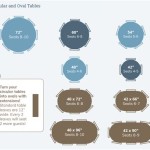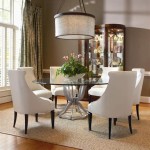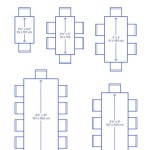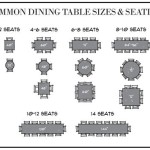Selecting the Right Rug for a Round Dining Table
A round dining table presents a unique design opportunity in a dining space. Unlike rectangular tables that often dictate the layout of a room, a round table offers flexibility and encourages conversation. However, choosing the appropriate rug to complement a round dining table can be challenging. The rug serves not only as a visual anchor for the table but also provides comfort, protects the flooring, and absorbs sound. This article explores the crucial aspects of selecting the ideal rug for a round dining table, covering size considerations, shape compatibility, material choices, and style considerations.
Determining the Appropriate Rug Size
The size of the rug is paramount to ensuring functionality and aesthetics in a dining area. A rug that is too small can make the table appear isolated and the room feel disjointed. Conversely, a rug that is too large can overwhelm the space and detract from the table's focal point. The key is to strike a balance that allows diners to comfortably pull chairs in and out without the chair legs catching on the rug's edge.
Generally, a rug should extend at least 24 to 30 inches beyond the perimeter of the round table. This measurement provides sufficient space for chair movement. For example, if the round dining table has a diameter of 48 inches (4 feet), the rug should ideally have a diameter of at least 96 inches (8 feet) to 108 inches (9 feet). This ensures that the chairs remain on the rug even when occupied and pulled away from the table.
To accurately determine the appropriate rug size, it is recommended to physically measure the table diameter and then add 48 to 60 inches to this measurement. This approach provides a practical and visual understanding of how the rug will fit within the dining area. It is also beneficial to use painter's tape to outline the potential rug size on the floor to visualize the proportions before making a purchase.
Consider the room's dimensions as well. In smaller dining spaces, adhering strictly to the 24-30 inch rule may result in a rug that dominates the room. In such cases, slightly reducing the rug size, while still ensuring chair functionality, can be a more visually appealing compromise. Conversely, in larger dining rooms, a larger rug may be necessary to create a sense of cohesion and prevent the dining area from feeling lost within the overall space.
Finally, the presence of other furniture in the room, such as buffets, sideboards, or display cabinets, should also factor into the rug size decision. The rug should not extend significantly under these pieces unless it is intended to anchor the entire dining area, including the additional furniture. Avoiding overlap between the rug and other furniture helps to maintain visual clarity and prevents the rug from appearing cluttered.
Choosing the Optimal Rug Shape
While a round rug might seem like the obvious choice for a round dining table, other shapes can also work effectively, depending on the aesthetic and spatial considerations. The shape of the rug impacts the visual flow of the room and can either enhance or detract from the table's overall presence.
Round Rugs: A round rug mirrors the shape of the dining table, creating a harmonious and cohesive look. This is a classic and generally safe option that visually centers the table and defines the dining area. Round rugs are particularly effective in smaller dining spaces, as they reinforce the circular flow of the room and prevent the area from feeling cramped.
Square Rugs: A square rug can provide a sense of structure and balance to a round dining table. The square shape contrasts with the circular table, creating visual interest and preventing the space from feeling too uniform. A square rug works well in rooms with strong architectural lines, as it complements the angular elements and grounds the round table within a more structured framework. Ensure that the square rug is large enough to accommodate the chairs comfortably.
Rectangular Rugs: While less intuitive, a rectangular rug can be used successfully with a round dining table if the room's layout dictates it. This option is particularly suitable for open-plan dining areas where the rug needs to define a larger zone. The rectangular rug can visually connect the dining area to adjacent spaces, creating a sense of continuity. When using a rectangular rug, position the round table towards one end of the rug, ensuring adequate space for chairs to move freely.
Other Shapes: Oval or even organically shaped rugs can also be considered, although these are less common. An oval rug can soften the edges of a rectangular room while still complementing the round table. Organically shaped rugs can add a whimsical and artistic touch to the dining area, breaking away from traditional norms and creating a unique focal point. These unconventional shapes require careful consideration of the room's overall design to ensure they integrate harmoniously.
Ultimately, the choice of rug shape depends on personal preference and the specific characteristics of the dining space. Experimenting with different shapes, either through visual aids or physical placement of temporary shapes on the floor, can help determine the most visually appealing and functional option.
Selecting Appropriate Rug Materials
The material of the rug significantly impacts its durability, maintenance requirements, and overall aesthetic appeal. Dining areas are subject to spills and foot traffic, making material selection a critical consideration. Different materials offer varying levels of resilience, texture, and visual warmth.
Wool: Wool rugs are renowned for their durability, stain resistance, and luxurious feel. Wool fibers naturally repel liquids, making them an excellent choice for a dining area where spills are likely. Wool rugs also provide excellent insulation and sound absorption, contributing to a more comfortable dining environment. They are, however, generally more expensive than synthetic options and require professional cleaning.
Synthetic Fibers (e.g., Polypropylene, Nylon): Synthetic rugs, such as those made from polypropylene or nylon, offer a cost-effective and durable alternative to wool. These materials are highly stain-resistant, easy to clean, and resistant to fading. Synthetic rugs are a practical choice for households with children or pets, as they can withstand heavy use and are easily maintained. While they may lack the luxurious feel of wool, advancements in manufacturing have resulted in synthetic rugs that closely mimic the look and texture of natural fibers.
Jute and Sisal: Jute and sisal rugs provide a natural and textured look that complements a variety of dining room styles. These natural fibers are durable and eco-friendly, adding a touch of rustic charm to the space. However, jute and sisal rugs are less stain-resistant than wool or synthetic options and can be more difficult to clean. They are also more prone to shedding, which may require regular vacuuming. Consider these factors when selecting a jute or sisal rug for a dining area.
Cotton: Cotton rugs are soft, lightweight, and relatively inexpensive. They are available in a wide range of colors and patterns, making them a versatile choice for dining areas. However, cotton rugs are less durable and stain-resistant than wool or synthetic options. They are also prone to shrinking when washed, requiring careful cleaning. Cotton rugs may be a suitable option for dining areas with light foot traffic and minimal risk of spills.
Blends: Rugs made from a blend of different materials can offer a balance of benefits. For example, a wool-synthetic blend can combine the durability and stain resistance of synthetic fibers with the luxurious feel of wool. Consider the specific properties of each material in the blend when making a selection to ensure the rug meets the needs of the dining space.
The pile height of the rug also matters. A low-pile rug is generally more practical for a dining area, as it is less likely to trap crumbs or snag on chair legs. A high-pile rug, while plush and comfortable, can be more challenging to clean and may not be suitable for high-traffic areas.
Considering Style and Design
The style and design of the rug should complement the overall aesthetic of the dining room and reflect personal preferences. The rug serves as a visual element that ties the room together, enhancing its overall appeal. Considering color, pattern, and texture is crucial to creating a cohesive and attractive dining space.
Color: The color of the rug should complement the existing color palette of the dining room. Neutral colors, such as beige, gray, or ivory, are versatile and can work well with a variety of table styles and décor. Bold colors, such as red, blue, or green, can add visual interest and create a focal point in the room. Consider the existing wall color, furniture finishes, and accent colors when selecting a rug color. A rug with a similar color to the walls can create a sense of spaciousness, while a rug with a contrasting color can add drama and definition.
Pattern: The rug pattern should complement the overall style of the dining room. Geometric patterns can add a modern and structured feel, while floral patterns can create a more traditional and romantic ambiance. Consider the existing patterns in the room, such as those on upholstery or window treatments, to ensure a harmonious balance. A rug with a subtle pattern can add texture and visual interest without overwhelming the space, while a rug with a bold pattern can make a statement and become the focal point of the room.
Texture: The texture of the rug can significantly impact the overall feel of the dining room. A plush and luxurious rug can add warmth and comfort, while a flatweave rug can create a more casual and contemporary look. Consider the material of the rug and its pile height when evaluating its texture. A wool rug with a high pile can provide a soft and inviting feel, while a jute rug with a flat weave can offer a more rustic and natural texture.
Style Compatibility: The rug should be consistent with the overall style of the dining room. A modern dining room may benefit from a rug with a minimalist design and clean lines, while a traditional dining room may be complemented by a rug with an ornate pattern and rich colors. Consider the style of the dining table and chairs when selecting a rug. A sleek and contemporary table may pair well with a geometric rug, while a rustic and farmhouse-style table may be enhanced by a jute or sisal rug.
Ultimately, the choice of rug style and design is a matter of personal preference. However, considering the existing elements of the dining room and ensuring a cohesive and harmonious balance will result in a visually appealing and functional space.

Rules Of Thumb For Rugs Under Round Dining Tables Inspiration

Rules Of Thumb For Rugs Under Round Dining Tables Inspiration

6 Rules For Choosing A Dining Room Rug Pretty Souces Stonegable

Rules Of Thumb For Rugs Under Round Dining Tables Inspiration

Best Dining Room Rugs 2024

8 Tips To Pick The Perfect Round Rugs For Dining Room Silk Road

Rules Of Thumb For Rugs Under Round Dining Tables Inspiration

27 Rugs Under Round Tables To Add A Wow Factor In Your Dining Room

Simple Rules For Dining Room Rugs Floorspace

10 Tips For Getting A Dining Room Rug Just Right
Related Posts








